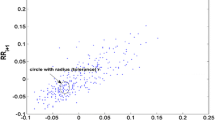Abstract
The main purpose of this study is to investigate twice a day simple 9-step tai chi effects of the center of pressure (COP) and physiological signals of elderly people. Data are collected from the COP signals, electromyography (EMG), and pulse oximetry for 1 min for the period of 12 weeks. The COP signals are analyzed using multivariate empirical mode decomposition and multivariate multiscale entropy to work out and compare the complexity index (CI). Subjects in this experiment are over 65 years old who are divided into 11 men and 7 women; the average age is 74 ± 8.18 years. In conclusion, it is found that tai chi exercise can improve human body balance by just walking some simple steps in our experiment. However, we cannot find any effect or improvement in the pulse oximetry and EMG signals analysis.






Similar content being viewed by others
References
World Health Organization (2007) WHO global report on falls prevention in older age, World Health Organization
Ahmed MU, Mandic DP (2012) Multivariate multiscale entropy analysis. IEEE Signal Process Lett 19(2):91–94
Sezer O, Ferdjallah M (2005) Adaptive autoregressive model for the analysis of center of pressure in healthy subjects during quiet standing. In: IEEE 48th Midwest Symposium on Circuits and Systems, vol. 1. Covington, pp 495–498
Snoussi H, Amoud H, Doussot M, Hewson D, Duchene J (2006) Reconstructed phase spaces of intrinsic mode functions. In: Application to Postural Stability Analysis, Engineering in Medicine and Biology Society. EMBS ‘06. 28th Annual International Conference of the IEEE, New York, pp 4584–4589
Huang NE, Shen Z, Long SR, Wu MC, Shih HH, Zheng Q, Yen NC, Tung CC, Liu HH (1998) The empirical mode decomposition and the Hilbert spectrum for nonlinear and nonstationary time series analysis. Proc R Soc Lond 454:903–995
Freitas SMSF, Wieczorek SA, Marchetti PH, Duarte M (2005) Age-related changes in human postural control of prolonged standing. Gait Posture 22:322–330
Rehman N, Mandic DP (2010) Multivariate empirical mode decomposition, in Proc. Roy Soc A 466:1291–1302
Rehman N, Mandic DP (2010) Filter bank property of multivariate empirical mode decomposition, IEEE Trans. Signal Proc 59:2421–2426
Costa M, Goldberger AL, Peng CK (2002) Multiscale entropy analysis of complex physiologic time series. Phys Rev Lett 89:068102
Costa M, Goldberger AL, Peng CK (2005) Multiscale entropy analysis of biological signals. Phys Rev E 71:021906-1–02190618
Thuraisingham RA, Gottwald GA (2006) On multiscale entropy analysis for physiological data. Phys A 366:323–332
Liu Q, Wei Q, Fan SZ, Lu CW, Lin TY, Abbod MF, Shieh JS (2012) Adaptive computation of multiscale entropy and its application in EEG signals for monitoring depth of anesthesia during surgery. Entropy 14(6):978–992. doi:10.3390/e14060978
Costa M, Healey JA (2003) Multiscale entropy analysis of complex heart rate dynamics: discrimination of age and heart failure effects, computers in cardiology 30:705–708
Acknowledgments
This research is supported by Ministry of Science and Technology in Taiwan through Grant number of NSC102-2221-E-155-028-MY3. This research is also supported by the Center for Dynamical Biomarkers and Translational Medicine, National Central University, Taiwan which is sponsored by Ministry of Science and Technology (NSC102-2911-I-008-001).
Author information
Authors and Affiliations
Corresponding author
About this article
Cite this article
Huang, CW., Chen, WH., Chu, HH. et al. Simple tai chi exercise for improving elderly postural stability via complexity index analysis. Artif Life Robotics 20, 42–48 (2015). https://doi.org/10.1007/s10015-014-0193-6
Received:
Accepted:
Published:
Issue Date:
DOI: https://doi.org/10.1007/s10015-014-0193-6




